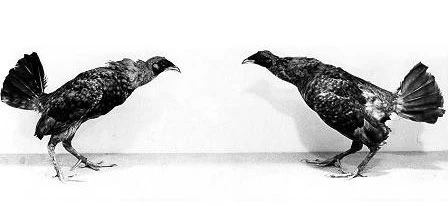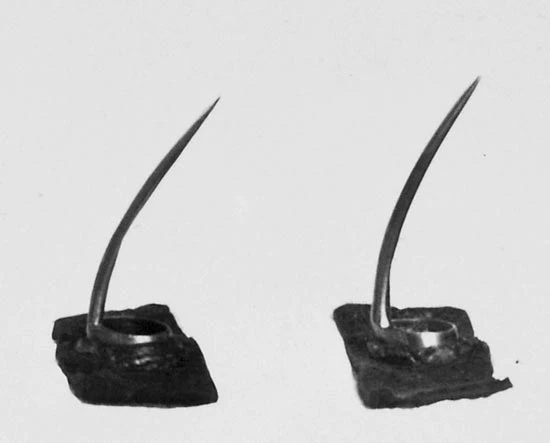Cock fighting
Introduction
Cockfighting featured prominently on the rural calendar, and was popular with all sections of society throughout Wales until the early 19th century.
Originally introduced to Britain by the Romans, cockfighting was popular among all social classes in Wales from the Middle Ages until the mid nineteenth century. Cockpits were common in most villages and spectators travelled from near and far to attend the fights.
Cocks would be trained for many months before fighting, and were looked after by men called 'feeders'. Birds practised sparring every day and after exercise were fed and watered. The correct diet was extremely important, and each feeder followed his own secret feeding programme: brandy, raw steak, maggots and even urine were just some of the varied ingredients used.
The fight
Spurs worn by fighting gamecocks.
Before a fight the cock was fitted with sharp steel or silver spurs (which could fatally wound an opponent in a single strike) and then brought to the middle of the pit. Here it stood, facing its opponent, only inches apart. At a signal from the master of the match, the battle began, and continued until one bird was killed or badly injured. Charms thought to protect and safeguard fighting cocks were sometimes used. These included biblical verses or cryptic words and signs, which were written on pieces of paper small enough to be slotted into the spurs. Superstitious owners also believed that birds fed with soil from under the church altar would become unbeatable and capable of killing all opponents. Such spells and charms were annulled, however, if the fight took place on the hallowed ground of a churchyard, where it was thought that bouts could not be affected by external forces.
The Welsh Main
Glass rummer from Pontypridd, inscribed with an image of fighting cocks, with the name J. Lewis. 1850.
A great number of cockfighting bouts were held during Easter. One of the severest tests on the cockfighting calendar was the Welsh Main, practised both in England and Wales, when only the best birds competed and large amounts of money were laid on the outcome. The Main usually featured over thirty birds, which fought each other head to head until only one was left standing. Other variants of cock fighting included 'shying at cocks', when spectators hurled pieces of wood at a bird in the pit, attempting to knock it over. 'Throwing at cocks' was particularly cruel and involved tying birds to a stake and shooting at them with staves.
The popularity of cock-fighting in Wales peaked during the eighteenth and early nineteenth centuries, at a time when a series of religious revivals nationwide condemned sports and pastimes as sinful activities which guaranteed hell and damnation for all involved. The Prevention of Cruelty to Animals Act in 1849 made cock-fighting illegal, both to protect the birds' welfare and to stop the gathering of frequently unruly spectators who so enjoyed the gambling and heavy drinking usually associated with the contests. We can be sure, however, that cock fights continued to be held illegally long afterwards, and as late as 1952 a cockfighting act was passed making it an offence to possess any instruments associated with the sport.
Cockpits
Both covered and open air pits were used for cockfights. The circular indoor cockpit re-erected at St Fagans National History Museum stood originally in the yard of the Hawk and Buckle Inn, Denbigh, and although its exact date is uncertain, may well have been built during the late seventeenth century.
Since none of the cockpit's original indoor fixtures remained when it was acquired by the Museum in 1965, the centre stage, surrounding gangway and two-tiered seating accommodation are all modern constructions.
Further reading
Owen, Elias, 'Churchyard Games in Wales', The Reliquary and Illustrated Archaeologist, vol 2 (1896), 154-161.
Peate, Iorwerth C., 'The Denbigh Cockpit and Cockfighting in Wales', Denbighshire Historical Society Transactions, vol.19 (1970), 125-132.
Author: Emma Lile, Curator: Traditional Music, Sports & Customs. Amgueddfa Cymru



Comments - (1)